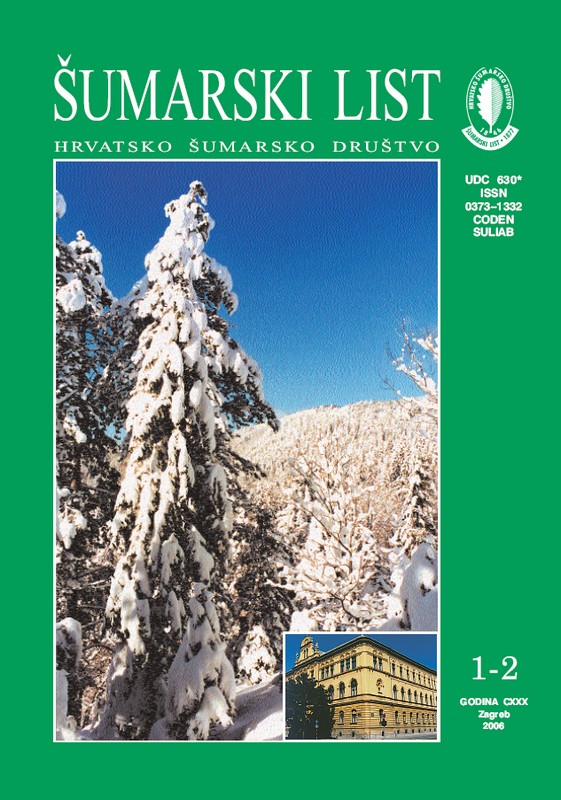
broj: 1-2/2006
pdf (19,7 MB) |
|
||||||||||||||
| IZVORNI ZNANSTVENI ČLANCI | ||
| Josip Franjić, Željko Škvorc, Andraž Čarni | UDK 630* 181.1 + 188 (001) | |
| Distribution of Crataegus nigra Waldst. et Kit. in Croatia and its Importance for Forest Edge Vegetation Formation pdf HR EN | 3 | |
| Juraj Zelić | UDK 630* 242 + 651 (001) | |
| The Influence of Intensively Thinning on Valuably Shares Of Assortiments Of Meturing Beech Assotiation pdf HR EN | 9 | |
| Sandra Golubić | UDK 630* 233 + 114.5 (001) | |
| Possibilities of waste disposal on the area of the Međimurje County in the case of the Totovec waste disposal yard pdf HR EN | 21 | |
| PREGLEDNI ČLANCI | ||
| Josip Karavla | UDK 630* 272 | |
| Dendrological characteristics of the City of Zagreb Green Horseshoe Suggestion for the regeneration of its eastern part pdf HR EN | 31 | |
| Dalibor Ballian | UDK 630* 165 | |
| Markers and Basic Mesaures of Genetic Variability Significant in Molecular Genetic Studies pdf HR EN | 41 | |
| Summary: The paper presents basic application of molecular and genetic markers used in studies of forest trees, that is, for measuring of genetic variability, which may be obtained by its usage. Thus, all measures of genetic variability can be divided to those that are important for evaluation of the present level of genetic variability, genetic structure of the population and genetic differentiation between the populations. Even though a small part of genetic information of a plant organism such as forest trees can be included into the studies with biochemical and molecular markers, they show their superiority in comparison to morphologic and physiologic genetic markers. The problem of choice of an adequate marker can serve for analysis of populations, which is in a direct relation with the applied method and the possibility of its presence in a plant organism. Therefore with the means of biochemical and molecular markers, that is, their usage and the analyses of measures that serve to determine the genetic variability itself, we can only obtain a small portion of a total genetic information that is contained in a plant organism such as forest trees, i. e. its population. Even though the markers are the means to view only a smaller part of variability, the biochemical and molecular markers show such traits, and are applicable means for studying genetic variability within and among populations. Also the biochemical and molecular markers show good traits in ecological studies, particularly in stress situations (dilapidation – drying of forests) in which we more frequently come across among forest trees. All measures of genetic variability that are presented in this study have an overall applicability on two levels of investigations, inter and intra population studies. All presented measures of genetic variability obtained by analysis of biochemical and molecular markers have an overall application in forest practice, since they give good information about genetic structure of the forest trees populations. Thus, based on such pieces of information we can suggest necessary measures for managing of forest resources, and strive for maintenance and correcting of the genetic structure of the forests. | ||
| Dario Kremer, Ksenija Karlović, Vesna Židovec | UDK 630* 164 | |
| Morphometric Research of Natural Populations of Ruscus Hypoglossum L. in Croatia pdf HR EN | 47 | |


